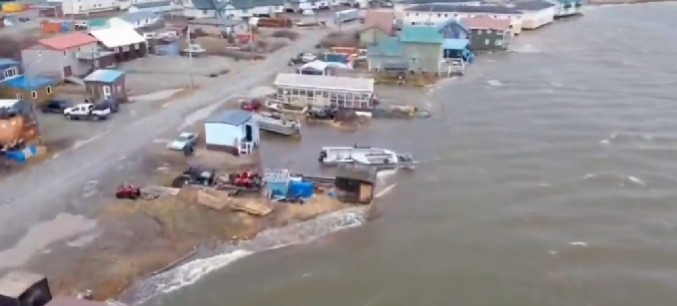Rain and wind were forecast Wednesday along Alaska’s coast, where two remote Native villages were left in ruins after the remnants of Typhoon Halong tore through the region — and officials scrambled to find shelter for more than 1,500 displaced residents.
According to The Associated Press, the weekend storm unleashed powerful winds and storm surges that battered low-lying communities across the Yukon-Kuskokwim Delta, nearly 500 miles southwest of Anchorage. At least one person was killed and two others remain missing. The Coast Guard rescued two dozen people after their homes were swept out to sea.
Hundreds of evacuees have taken refuge in local schools — including one with no working toilets — as emergency crews continue damage assessments and coordinate relief efforts.
“It’s catastrophic in Kipnuk. Let’s not paint any other picture,” said Mark Roberts, incident commander with the state emergency management division. “We are doing everything we can to continue to support that community, but it is as bad as you can think.”
Across the region, back-to-back storms displaced more than 1,500 residents. Dozens have been flown to a temporary shelter at the National Guard armory in Bethel — a regional hub of 6,000 people — and officials are considering relocating evacuees to longer-term housing in Fairbanks and Anchorage.
The hardest-hit communities, Kipnuk (population 715) and Kwigillingok (population 380), are off Alaska’s road system and can be reached only by air or water.
Among those awaiting evacuation to Bethel on Tuesday was Brea Paul of Kipnuk, who described witnessing homes floating away in the moonlight.
“Some houses would blink their phone lights at us like they were asking for help but we couldn’t even do anything,” she said in a text message.
The next morning, Paul captured video of a home submerged nearly to its roofline as it drifted past hers. She and neighbors gathered in the school gym Monday night, singing songs as they tried to comfort one another.
“It’s so heartbreaking saying goodbye to our community members not knowing when we’d get to see each other,” Paul said.
Roughly 30 miles away in Kwigillingok, authorities confirmed one woman had died and called off the search for two men whose home was swept away. The town’s school — the only building with full power — sheltered 400 people Monday night, though it had no functioning toilets. Portable “honey buckets” were being used, according to state officials.
A preliminary report found every home in Kwigillingok sustained damage, with about three dozen dislodged from their foundations.
Power systems were flooded in Napakiak, and severe erosion was reported in Toksook Bay. In Nightmute, residents reported floating fuel drums, a strong fuel odor, and a visible sheen on the water.
The Alaska National Guard has been activated to assist with recovery efforts, delivering food, water, generators, and communication equipment whenever weather conditions allow.
Officials warn that rebuilding could take months, especially as winter approaches and supplies must be flown or shipped in.
“Indigenous communities in Alaska are resilient,” said Rick Thoman, a climate specialist at the University of Alaska Fairbanks. “But, you know, when you have an entire community where effectively every house is damaged and many of them will be uninhabitable with winter knocking at the door now, there’s only so much that any individual or any small community can do.”
Thoman noted that Typhoon Halong’s remnants were likely intensified by unusually warm Pacific Ocean waters — a symptom of human-driven climate change that is making severe storms more frequent and destructive.
Three years ago, the remnants of another tropical system, Typhoon Merbok, caused widespread devastation across western Alaska.
Watch the video below:
IJRIJR


